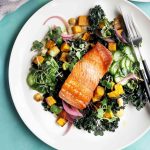Quinoa and rice may taste and even look similar, but they’re very different foods. While both are cooked in boiling water and have a nice, neutral taste, quinoa and rice are from distinct plant families, and offer some different health benefits. Quinoa and rice can be ground into flours to create wheat alternatives for gluten-free eaters (quinoa pasta and rice noodles are popular), and can also be served together in mixed grain dishes, but quinoa isn’t a grain at all, even though it’s typically classified as such. Which is the healthier choice? We asked an expert to weigh in.
What Is Quinoa?
Quinoa is a plant from the amaranth family. Neither a grain nor a type of rice, quinoa is a seed that originated in South America, and is now a popular ingredient across the Americas. Quinoa is known for its slightly nutty flavor and high fiber, protein, and vitamin and mineral content. Quinoa is naturally gluten-free. White quinoa is the most common form of quinoa, but there are other varieties, including red quinoa and black quinoa.
“Think of quinoa as a carb with benefits,” says Miranda Galati, MHSc, RD, Owner of Real Life Nutritionist Inc., “Like other carbohydrate-containing foods, quinoa provides energy. Because those carbs are packaged alongside protein and fiber, eating quinoa will minimize big swings in blood sugar and provide more stable energy and appetite. It also contains many important micronutrients to support your health and metabolism, including copper, iron, zinc, and folate.”
Here’s what the USDA shares about quinoa’s nutritional attributes for ¼ cup (45 grams):
Macronutrients
Calories: 170 calories
Total Fat: 2.5 g
Saturated Fat: 0 g
Cholesterol: 0 mg
Carbohydrates: 29 g
Fiber: 3 g
Sugar: 2 g
Protein: 6 g
Micronutrients:
Calcium: 19.8 mg
Potassium: 0 mg
Sodium: 0 mg
Iron: 1.8 mg
Vitamin A: 0 mcg RAE
Vitamin C: 0 mg
Vitamin D: 0 mcg
What Is Rice?
Rice is a cereal grain available in several domesticated varieties, including white rice and brown rice, long-grain rice and short-grain rice. Rice is naturally gluten-free, and long-grain brown rice is considered to be the healthiest type.
“Rice is a great source of carbohydrates for quick energy,” says Galati. “It contains important micronutrients like manganese, selenium, and niacin. If you choose brown rice, you’ll benefit from a little extra fiber and a few more micronutrients, too.“
Here’s what the USDA shares about nutritional attributes for 100 grams of long-grain brown rice:
Macronutrients
Calories: 366 calories
Total Fat: 3.31 g
Saturated Fat: 0 g
Cholesterol: 0 mg
Carbohydrates: 76.7 g
Fiber: 3 g
Sugar: 0 g
Protein: 7.25 g
Micronutrients
Calcium: 8 mg
Potassium: 250 mg
Sodium: <2.5 mg
Iron: 1.824 mg
Vitamin A: 0 mcg RAE
Vitamin C: 0 mg
Vitamin D: 0 mcg
Is Quinoa Healthier Than Rice?
“Quinoa and rice can both fit in a healthy diet—and if you like both, I encourage you to alternate between the two,” explains Galati. Still, one is slightly healthier than the other. “Quinoa beats rice in terms of blood sugar management and nutrient density since it contains extra fiber, protein, vitamins, and minerals,” Galati adds.
“If you like both, opt for quinoa more often for its nutrient density,” she advises. “But if you prefer rice, there’s plenty of other ways to add extra nutrition to your diet to make up for the difference.”
Can You Use Quinoa Instead of Rice?
Yes, you can use quinoa instead of rice in most recipes. Quinoa can easily adapt to any flavor profile, similar to rice, and can be served alongside curries, stir-fries, and stews, stirred into soups, topped with sauces, and more.
“Quinoa is a great substitute for rice if you’re looking for some extra nutrition,” Galati says. “To make the swap, simply prepare quinoa according to package directions and substitute 1 cup rice for 1 cup quinoa on your plate.” For extra flavor and nutrition, Galati recommends cooking your quinoa in chicken or vegetable broth (bone broth works to add protein!), and stirring in lemon juice and fresh herbs when it’s done cooking.
Quinoa and rice can also be blended for a texturally and nutritionally satisfying meal or side dish. Try adding quinoa to fried rice, pilafs, or cheesy rice dishes.
However, because quinoa doesn’t contain the natural starchiness of rice, it cannot be used in some dishes that rely on that starch to stick together, such as risotto or crispy rice cakes.






